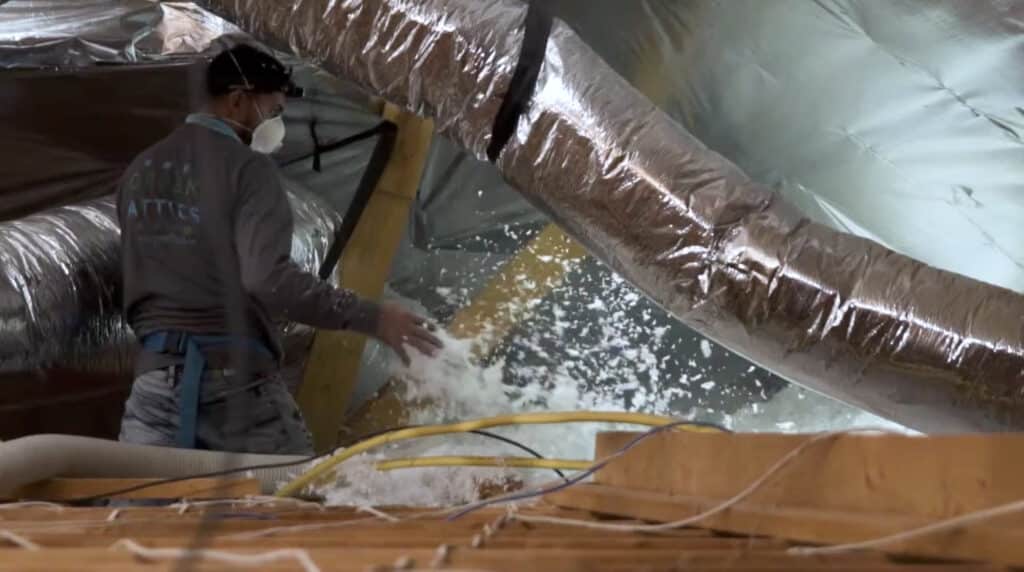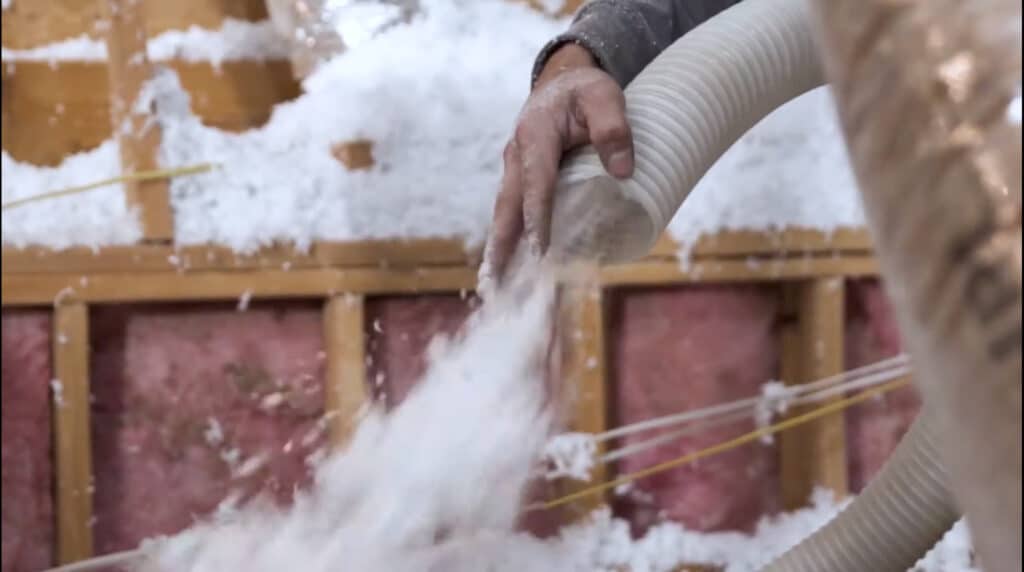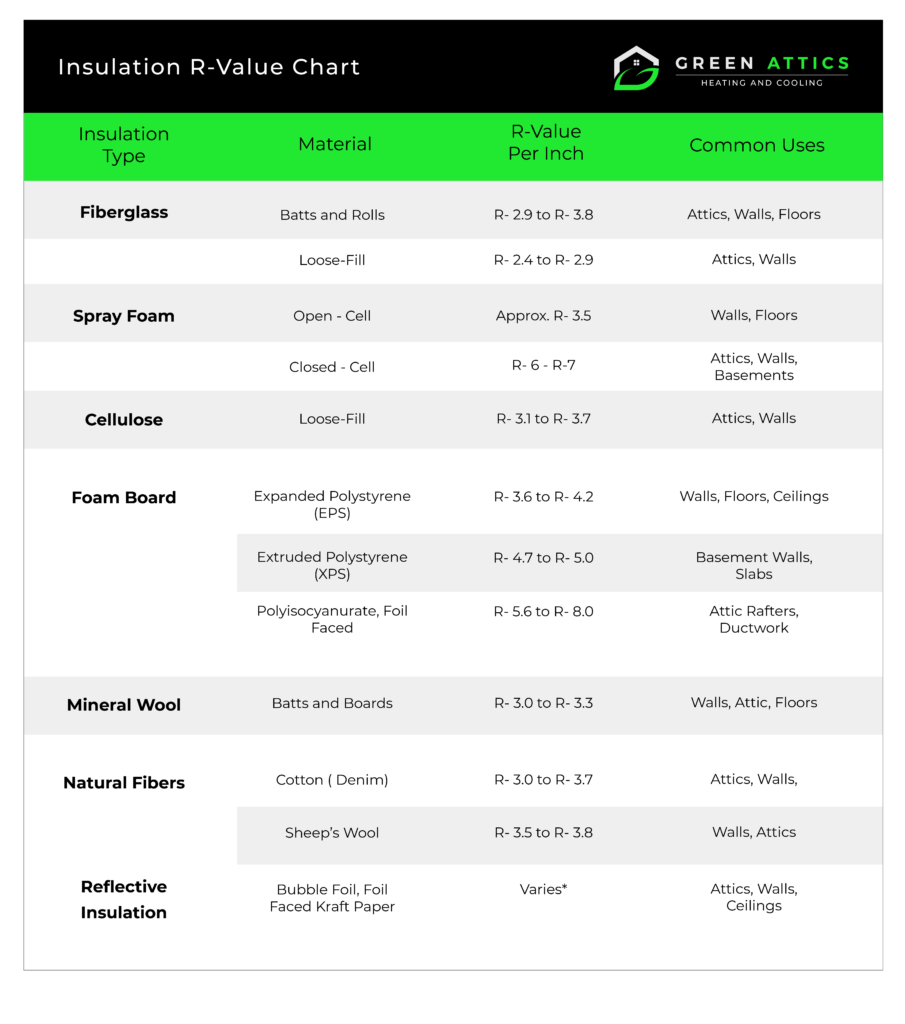Attic insulation plays a crucial role in maintaining the energy efficiency and comfort of your home. Whether you are looking to install new insulation or replace insulation, understanding the costs involved is essential. This guide provides comprehensive information on the various factors that influence attic insulation costs, the benefits of insulating your attic, and how to calculate the amount of insulation you need. By the end of this article, you’ll have a clear idea of what to expect when planning your attic insulation project.
Average Cost to Insulate an Attic
The average cost to insulate an attic can vary significantly based on several factors, including the type of insulation material used, the attic space’s size, and the installation’s complexity. Based on our experience here in DFW, attic insulation typically costs between $4,500 and $8,000, depending on the size of the attic, the materials used, and additional services like air sealing or insulation removal. Larger or more complex projects can cost as much as $10,000 to $12,000.
Regional pricing can also impact costs. For example, in the Dallas-Fort Worth (DFW) area, prices might be slightly higher than the national average. Additionally, if your attic requires insulation removal, expect the total cost to increase. It’s essential to get a detailed quote from a trusted insulation contractor to understand the full scope of your project.
Attic Insulation Install Cost

Amount of Insulation
The amount of insulation required for your attic is a major factor in the overall cost. Larger attic spaces require more insulation material, resulting in higher costs. For instance:
- Blown-in insulation costs around $1 to $3 per square foot.
- Spray foam insulation can cost as high as $3 to $7 per square foot.
When calculating how much insulation in the attic you need, consider the R-value, which measures the insulation’s effectiveness. Higher R-values offer better thermal resistance but come at a higher cost. Consulting with an insulation professional can help you determine the ideal amount of insulation needed to achieve the desired energy efficiency without overspending.
Insulation Material
The type of insulation you choose greatly affects your overall cost:
- Fiberglass: The most affordable option, costing between $0.50 to $2 per square foot.
- Cellulose: Slightly more expensive material cost, typically $1 to $3 per square foot.
- Spray Foam: The most expensive, ranging from $3 to $7 per square foot due to its superior insulating properties.
Each insulation type has its pros and cons. Fiberglass is affordable and easy to install but may not provide the same level of air sealing as spray foam. Cellulose is eco-friendly and offers good thermal performance but can be harder to install. Spray foam provides high R-values and excellent air sealing but comes at a premium price.
Air Sealing Costs
Air sealing is a critical step in maximizing the effectiveness of your attic insulation. When you prevent air leaks, air sealing improves energy efficiency and overall comfort. Homeowners can expect to pay between $500 and $1,500 for professional air sealing services, depending on the attic size and the work required.
Investing in air sealing ensures better insulation performance and long-term energy savings. A professional insulation contractor can assess your attic and provide a comprehensive air-sealing solution tailored to your home’s needs.
Removing Old Insulation
If your attic has old, damaged, or insufficient insulation, removing it before installing new insulation is often necessary. The cost of insulation removal ranges from $1 to $2 per square foot. This process includes safely removing and disposing of the old insulation material, which adds to the overall project cost.
Removing old insulation is crucial for maintaining indoor air quality and ensuring new insulation performs at its best. Old insulation can harbor mold, pests, and contaminants that reduce its effectiveness and compromise home air quality.
Labor
Labor costs make up a significant part of attic insulation projects. Labor typically ranges from $1 to $3 per square foot, depending on the complexity of the job and the type of insulation being installed. More complex attic spaces with hard-to-reach areas or existing structural issues can increase labor costs.
Hiring a professional insulation contractor ensures the job is done right, minimizing the risk of future issues like uneven insulation or air leaks. To get the best price for labor, it’s a good idea to compare multiple quotes from different contractors in your area.
Inspection
An inspection is essential before installing insulation, as it helps identify any underlying issues that need to be addressed, such as air leaks, poor wall insulation or moisture damage. Depending on the size of the attic and its condition, inspections generally cost between $100 and $300. However, we build it into the cost of our jobs.
A thorough inspection allows the installer to tailor the insulation solution to your needs, ensuring optimal performance and longevity.
Our Attic Insulation Installation Process

At Green Attics, our attic insulation installation process is designed to ensure maximum energy efficiency and comfort. We start with a detailed inspection of your attic to identify issues such as air leaks, moisture, and existing insulation conditions. Based on this inspection, we provide a comprehensive quote outlining the total cost, including insulation materials, labor, and any additional services like air sealing or insulation removal.
After the inspection, we safely remove outdated insulation (if necessary), ensuring the attic is properly prepared for the new material. We then install the chosen insulation, whether it’s fiberglass, cellulose, or spray foam, ensuring even distribution and proper sealing. Finally, we conduct a post-installation inspection to confirm that everything is installed correctly and functioning as expected. Our goal is to provide a seamless and efficient insulation process that maximizes the energy efficiency and comfort of your home.
Benefits of Installing Attic Insulation
Proper attic insulation offers numerous benefits, including:
- Energy Bill Savings: Maintaining a stable indoor temperature can help attic insulation reduce heating and cooling costs by up to 60%.
- Improved Air Quality: Insulation helps reduce drafts and airborne contaminants, leading to better indoor air quality.
- Enhanced Comfort: Proper insulation eliminates drafts and maintains consistent temperatures throughout the home.
- Longer HVAC Lifespan: Insulation reduces the strain on your HVAC system, leading to fewer repairs and a longer operational life.
How To Calculate How Much Insulation You Need
Calculating the amount of insulation needed for your attic involves measuring the space and determining the appropriate R-value for your climate. In the DFW area, the recommended R-value for attic insulation is between R-30 to R-60. Here’s how you can calculate your insulation needs:
- Measure the square footage of your attic.
- Determine the R-value based on your climate zone.
- Use an insulation calculator or consult a professional to determine the amount of material required.
Accurate calculations help ensure that you install enough insulation to optimize energy efficiency without overspending on unnecessary materials.
We’ve put together this insulation R-value chart you can quickly check what you need:

Attic Insulation Cost by Type Per Square Foot
Blown-In Insulation
Blown-in insulation is an affordable and effective option for many homeowners. It’s also the most common type of insulation you’ll find in a residential home. It typically costs $1 to $2 per square foot and is ideal for attics with irregular spaces or hard-to-reach areas. Blown-in insulation provides excellent coverage, filling gaps and cavities to create a consistent insulation layer.
Spray Foam Insulation
Spray foam insulation is known for its superior insulating properties and air-sealing capabilities. It costs between $3 to $7 per square foot, making it the most expensive option. However, the high R-value and excellent air sealing it provides make spray foam a worthwhile investment for long-term energy savings and improved comfort.
Insulation Replacement Cost
Replacing bad insulation generally costs between $2,000 and $5,000, depending on the attic size and the insulation material used. This price includes removing the former insulation, disposing of it, and installing new insulation. The price will also change depending on the insulation type you choose.
Replacing outdated insulation significantly improves energy efficiency, especially if the old material has degraded or been compromised by mold or pests. A reputable contractor can help you assess your current insulation and provide a detailed replacement plan for new attic insulation.
Benefits of Insulating Your Attic

- Energy Savings: Proper insulation typically cuts energy bills by 30% to 60%, especially during peak seasons.
- Better Air Quality: Insulation reduces the entry of outdoor pollutants and helps control humidity, leading to improved indoor air quality.
- Enhanced Comfort: Insulation helps regulate temperature, eliminating drafts and creating a more comfortable living environment.
Tips to Save Money on Attic Insulation
- Take advantage of rebates: Check local utility rebates or government incentives to help offset costs.
- Do some prep work yourself: Clearing the attic space before professionals arrive can help reduce labor costs.
- Look for discounts: Professional attic insulation companies run specials that you can use to get discounts.
DIY Attic Insulation Cost vs. Hiring a Professional
DIY insulation may seem cost-effective, with materials ranging from $0.50 to $2 per square foot, but it requires a significant amount of time, effort, and expertise. Mistakes during installation can lead to reduced efficiency and higher long-term costs.
Hiring a professional costs more upfront—typically between $1 and $4 per square foot for labor—but ensures a proper installation and long-term energy savings. If you’re unsure about your ability to handle the project, hiring a professional is the safer and more efficient option.
FAQs
-
Do I need to air-seal my attic before installing insulation?
Yes. Air sealing is critical to ensure insulation performs at its best, as it prevents conditioned air from escaping and reduces energy waste.
-
What insulation has the highest R-value?
Spray foam insulation, specifically closed-cell spray foam, has the highest R-value, offering up to R-7 per inch. This makes it one of the most effective insulation materials in terms of thermal resistance and energy efficiency.
-
What is the best type of attic insulation?
The best insulation type depends on your home’s specific needs. Spray foam is often considered the best due to its high R-value and air-sealing abilities. However, blown-in insulation (fiberglass or cellulose) is an excellent option for those seeking a more affordable, yet still effective, insulation solution.
-
Will new insulation make my attic too hot?
Properly installed insulation won’t make your attic too hot. In fact, it will regulate the attic temperature by reducing heat transfer. Additionally, ensuring proper ventilation, such as with solar attic fans, will help prevent overheating in the attic.
-
What R-value is best for my climate?
For the Dallas-Fort Worth (DFW) area, the recommended R-value is between R-30 and R-60. This level of insulation ensures optimal thermal resistance, helping to keep your home cool in the summer and warm in the winter.
-
How much does attic insulation cost in 2025?
The cost of attic insulation in 2025 varies based on the type of insulation selected, with prices ranging from $1.50 to $7 per square foot, depending on material and installation factors.
-
What is the average cost of attic insulation per square foot?
The average insulation cost per square foot can range from $2 to $5, depending on the type of insulation and the complexity of the insulation work required.
-
What types of insulation are available for attics?
Common types of attic insulation include batt insulation, cellulose insulation, fiberglass insulation, and reflective insulation, each with varying costs and installation methods.
-
How does the type of insulation affect the cost of attic insulation?
The type of insulation significantly impacts the cost; for instance, fiberglass insulation typically costs around $3 per square foot, while cellulose insulation may be priced at approximately $2 per square foot.
-
Does insulation in an attic make a difference?
Absolutely. Insulation in an attic makes a significant difference in your home’s energy efficiency, reducing both heating and cooling costs by up to 60%. It also helps maintain a more consistent indoor temperature, improving comfort throughout the home.
-
Is adding insulation to an attic worth it?
Yes, adding insulation to your attic is a cost-effective investment that pays off in energy savings. It also increases your home’s comfort, extends the lifespan of your HVAC system, and can improve indoor air quality.
-
How much does it cost to insulate an 1,800 sq ft attic?
For an 1,800 sq ft attic, insulation costs can range between $4,500 and $12,600, depending on the insulation material:
Blown-in insulation costs between $1,800 and $3,600.
Spray foam insulation can cost as much as $5,400 to $12,600. -
How much does 1,500 sq ft of insulation cost?
Insulating a 1,500 sq ft attic typically costs between $1,500 to $10,500, depending on the material:
Blown-in insulation typically ranges from $1,500 to $3,000.
Spray foam insulation can range from $4,500 to $10,500. -
What happens if your attic is not insulated?
Without attic insulation, your home will lose heat in the winter and gain heat in the summer, leading to higher energy bills and an overworked HVAC system. Additionally, uninsulated attics can create uncomfortable temperature fluctuations, drafts, and potentially lead to moisture issues or mold growth over time.
-
Can I DIY spray foam insulation?
While DIY spray foam kits are available, it’s highly recommended to hire a professional for this job. Spray foam installation requires specialized equipment and expertise to ensure it’s applied evenly and safely. Mistakes can lead to air gaps, structural damage, or even fire hazards around electrical fixtures.
-
Can attic insulation reduce both heating and cooling costs?
Yes, attic insulation can reduce both heating and cooling costs. When you prevent heat from escaping in the winter and stopping heat from entering in the summer, your HVAC system won’t need to work as hard, leading to year-round energy savings.
-
Can you over-insulate your attic?
Yes, it is possible to over-insulate your attic. Over-insulation can trap moisture and prevent proper ventilation, leading to issues like mold growth and poor air quality. It’s crucial to balance insulation with adequate ventilation to maintain a healthy, efficient attic space.
-
What is the cost to install insulation in an attic?
The cost to install insulation can range from $1.50 to $7 per square foot, influenced by the insulation type, labor costs, and whether old insulation is removed before new insulation is installed.
-
How does the size of your attic influence the cost of attic insulation?
The size of your attic directly affects the overall cost of attic insulation; larger attics will require more material and labor, leading to higher total costs.
-
Should I hire an insulation company for attic insulation work?
Hiring an insulation company is advisable, as they possess the expertise to ensure proper installation, which can significantly impact the effectiveness and longevity of the insulation in your attic.
-
What additional costs should I consider when insulate attic?
Additional costs may include the removal of old insulation, any necessary repairs to the attic floor or walls, and potential upgrades to ventilation systems, which can all contribute to the total cost of attic insulation.
-
Is it worth investing in high-quality insulation for my attic?
Yes, investing in high-quality insulation can lead to improved energy efficiency, reduced heating and cooling costs, and enhanced comfort in your home, making it a worthwhile investment in the long run.

